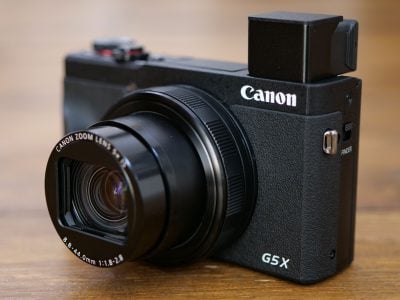Pentax K20D
-
-
Written by Gordon Laing
Pentax K20D verdict
The Pentax K20D is certainly a powerful and capable DSLR. It inherits an impressive core specification from its predecessor which includes a dust and weather-resistant body, built-in Shake Reduction, a decent optical viewfinder, innovative exposure modes, a wealth of custom options and the choice of recording RAW images in either Pentax’s own PEF or Adobe’s open DNG formats.
 |
To this Pentax has slightly increased the screen size to 2.7in, boosted the maximum sensitivity to 6400 ISO, added Live View facilities and an X-Sync port for external lighting, improved the optionally bundled 18-55mm kit lens, and most importantly, significantly increased the resolution from 10 to 14 Megapixels.
One of our major criticisms of the K10D has also been partly addressed here: the default output of the K10D could appear relatively dull and was often underexposed. While the same underexposure issues remained on our K20D, its default output was considerably punchier, suiting anyone who wants consumer-friendly JPEGs direct from the camera. Suffice it to say, you can also tweak these settings as much or as little as required, and the sharpening now even offers the choice of fine or coarse steps.
After the relatively noisy and smeared images from the 14 Megapixel Sony Alpha A350, we feared the worst for the K20D, but its new CMOS sensor co-developed by Samsung really delivers the goods. As you can see in our real-life results pages, the K20D held onto noticeably greater detail than the Alpha A350 at higher sensitivities and delivered preferable output across the board. Take it into a studio environment and it’s also capable of resolving a very fine degree of detail, especially in RAW mode. If you keep an eye out for its tendency to underexpose, the K20D can deliver superb images which are a step-up from most comparable DSLRs.
So far so good, but the K20D isn’t without its problems. The new Live View feature is basic to say the least. Lacking a live histogram, a usable magnified mode and the ability to change or even see exposure information, the K20D’s Live View implementation is of limited use and appears to have been bolted on without much thought to practical operation.
Staying with the screen, it may be 0.2in bigger than the K10D, but other manufacturers have raised the bar further. Canon’s now using larger 3in screens, while Sony’s employing vertically tilting platforms for easy framing at unusual angles. The new dust alert option is also of limited use, showing you where the bigger particles are lying, but not actually doing anything about it.
Then there’s the issues inherited from the K10D which sadly haven’t changed. The upper screen is useful in bright or dark-adapted conditions, but neither it nor the optical viewfinder can show ISO sensitivity and shots remaining at the same time. The Shake Reduction may boast three axes of motion, but like the K10D, just didn’t prove as effective as rival systems from Sony and Olympus.
The K20D also has semi-pro aspirations and while fulfilling some of the requirements, falls short on others. The body may be dust and weather-resistant for example, but the core isn’t built from magnesium alloy. And while models like Canon’s EOS 40D can fire-off over twice as many frames per second for roughly the same money, the K20D plods along at the same 3fps of budget models. Remember, this is a camera which at the time of writing was pitched at over 35% more than the Canon EOS 450D / XSi and the Sony Alpha A350.
So as always, before wrapping-up, how does the K20D compare to its current rivals?
Compared to Canon EOS 40D
 |
The closest model in terms of pricing to the K20D is Canon’s semi-pro EOS 40D. At first glance the K20D appears to trump the 40D with four extra Megapixels and built-in Shake Reduction, not to mention its innovative exposure modes and support for Adobe’s DNG RAW files.
But the EOS 40D has several key advantages including a magnesium alloy body, much faster 6.5fps continuous shooting, a bigger 3in screen, more usable Live View complete with supplied remote control software, 14-bit RAW files and optional Wifi and GPS connectivity.
The 40D’s body construction, faster continuous shooting and connectivity options make it better-suited to professional photographers, but you may place greater value on the K20D’s higher resolution and built-in Shake Reduction. It’s crucial to think very carefully which feature-set better-suits your requirements, while of course handling both in person. See our Canon EOS 40D review for more details.
Compared to Canon EOS 450D / Rebel XSi
 |
The Pentax K20D body is priced over 35% more than the Canon 450D / XSi at the time of writing, but as one of the most popular cameras around, it will inevitably be compared closely. In its favour, the Canon 450D / XSi has a comfortably lower price, a bigger 3in screen, more usable Live View complete with supplied remote control software and 14-bit RAW files.
Spending more on the K20D will get you two extra Megapixels, a tougher dust and weatherproof body with built-in Shake Reduction, an X-Sync port for external lighting, a vast array of customisation and the innovative exposure and RAW modes. While the K20D had the edge in image quality, the 450D / XSi was very close and of course the money you save could go towards a better stabilised lens.
Again it’s a case of weighing-up the different features and handling both cameras in person, but even with built-in Shake Reduction and a 14 Megapixel sensor, the K20D is looking a little expensive. See our Canon EOS 450D / XSi review for more details.
Compared to Sony Alpha DSLR-A350
 |
With 14 Megapixels and built-in anti-shake facilities, Sony’s Alpha DSLR-A350 has arguably the closest core specification to the K20D, but there are still significant differences. Not least is the price, which again at the time of writing saw the K20D body costing almost 35% more. Beyond a comfortably lower price, the A350 additionally boasts quicker Live View facilities and a vertically tilting monitor for easier framing at high or low angles. The Sony’s built-in anti-shake also proved more effective in practice.
It sounds like a slam-dunk for the Sony, but the K20D boasts noticeably superior image quality in our tests, along with a tougher dust and weatherproof body, a much bigger viewfinder, an X-Sync port for external lighting, a vast array of customisation, mirror-lockup and depth of field previews, along with the innovative exposure and RAW modes. It’s a better camera in traditional respects than the Sony, but can’t compete on the modern features. One approach will appeal more to you than the other, but there’s still that price difference to contend with. See our Sony Alpha DSLR-A350 review for more details.
Pentax K20D final verdict
Pentax has certainly made a number of improvements over the already very capable K10D, which in turn makes the K20D a powerful and feature-packed DSLR. The biggest and most important is of course the sensor, with the K20D delivering the most detailed images from a camera at its price point, while respectably keeping noise levels under control at higher sensitivities. This alone will sell it to many people.
Then there’s the small tweaks which really show Pentax is thinking about how photographers work. The exposure bracketing offers a range that’s genuinely useful for HDR work and the new one touch bracketing option minimises the subsequent effort required. The new custom image function gives you quick and easy access to image processing adjustments and includes not one but two different sharpening scales to work with.
The Hyper Program mode was of course present on the K10D, but remains a joy to use, extending the concept of Program shift into instant shutter and aperture priority when you want to make specific changes. This along with modes like Sensitivity priority really show Pentax innovating in areas which other manufacturers have long moved-on from.
 |
So the K20D, like its predecessor, is a wonderful tool in traditional photographic terms with some neat twists thrown in, but it disappoints in the more modern respects. The new Live View feature is severely limited compared to other cameras, neither offering the speed and flexibility of Sony’s system, nor the technical benefits of everyone else’s. The screen may also be bigger, but it’s fallen behind the size of Canon’s and the flexibility of Sony’s. And the Shake Reduction facility may reduce wobbles, but wasn’t as effective in our tests as those from Sony or Olympus.
The biggest problem facing the K20D though is price. At the time of writing, the body cost approximately 35% more than the Canon EOS 450D / XSi and Sony Alpha DSLR-A350. It may have a weatherproof body and technically out-resolve both models with finer detail at higher sensitivities, but there are many respects in which the others are superior, while coming in comfortably cheaper.
The K20D’s price elevates it beyond typical mid-range DSLRs into the semi-pro category and pitches it head to head against models like Canon’s EOS 40D. At first glance, the K20D appears to compare well with its four extra Megapixels and built-in Shake Reduction, but while the camera does indeed resolve more detail than the 40D, its built-in anti-shake facilities weren’t that impressive in our tests.
Crucially, the K20D also misses out on other aspects more commonly found in semi-pro models. It may have the upper screen and now sports an X-Sync port, but the body isn’t magnesium alloy and the 3fps continuous shooting speed is less than half that of the 40D’s 6.5fps. It’s also annoying not to find dedicated buttons for things like sensitivity and white balance, nor the possibility of seeing both ISO and shots remaining on either the top screen or through the optical viewfinder.
So the K20D finds itself in an uncomfortable position, looking pricey compared to mid-range DSLRs and not quite tough or fast enough to be considered a true semi-pro model. An unremarkable screen and restricted Live View system add further insult to injury.
But one look at the K20D’s images and you know you’re dealing with something special. It really does capture a great deal of detail and unlike Sony’s 14 Megapixel sensor and processing engine, this detail remains at higher sensitivities. And like the K10D before it, the decent viewfinder, comfortable grip, innovative exposure modes, twin control dials and vast degree of customisation makes it a great camera to use in traditional photographic terms.
If these are the things you look for in a DSLR, then we can easily recommend the K20D, but its relatively high price, disappointing Live View, tendency to underexpose and uncomfortable positioning rules out our Highly Recommended award. If you want more effective anti-shake, superior Live View, faster continuous shooting and a bigger or more flexible screen, then there are simply better or cheaper alternatives out there. As always, it’s crucial to weigh-up which features really mean most to you when shopping for a new DSLR and this applies more than ever here. And finally if you are sold on the K20D’s feature-set and handling, be sure to compare it with Samsung’s equivalent, the GX-20 which may be available at a cheaper price.
|
Bad points | Scores (compared to 2008 mid-range DSLRs) |
 | ||
Build quality: Image quality: Handling: Specification: Value:
Overall: |
17 / 20 19 / 20 16 / 20 18 / 20 16 / 20
86% | |||




